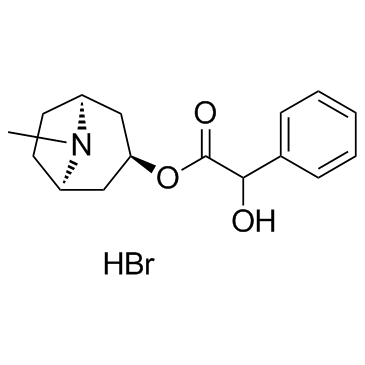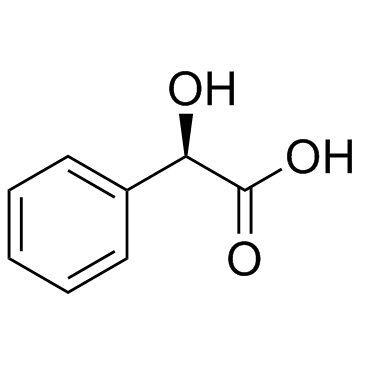Homatropine (Bromide)

Homatropine (Bromide) structure
|
Common Name | Homatropine (Bromide) | ||
|---|---|---|---|---|
| CAS Number | 51-56-9 | Molecular Weight | 356.25500 | |
| Density | 1.21g/cm3 | Boiling Point | 434.9ºC at 760 mmHg | |
| Molecular Formula | C16H22BrNO3 | Melting Point | 214-217 °C | |
| MSDS | N/A | Flash Point | 216.8ºC | |
Use of Homatropine (Bromide)Homatropine Bromide is muscarinic AChR antagonist that is an anticholinergic medication.Target: mAChRHomatropine is an anticholinergic medication that is an antagonist at muscarinic acetylcholine receptors and thus the parasympathetic nervous system. Homatropine (20 μM) alone produces a dose ratio of 259 in atrium from guinea-pigs. Homatropine (20 μM) produces a dose ratio of only 95.0 when combined with hexamethonium in atrium from guinea-pigs [1]. Homatropine has similar affinities for muscarinic receptors in stomach (pA2 = 7.13) and for those in atria mediating force (pA2 = 7.21) and rate (pA2 = 7.07) responses [2]. Homatropine [14C]methylbromide administrated rectal achieves higher and rapid peak plasma concentrations than by the other routes in rats whether HMB-14C is administered in a water-soluble suppository base or in aqueous solution, retained 28% of the 14C has been excreted in the urine while 56% remained in the large intestine after 12 hours. Unlabelled Homatropine methylbromide, given in rectal suppositories to anaesthetized rats, causes prompt blockade of the effects of vagal stimulation on pulse rate and of intravenous acetylcholine on blood pressure [3]. |
| Name | alpha-Hydroxybenzeneacetic acid 8-methyl-8-azabicyclo[3.2.1]oct-3-yl ester hydrobromide |
|---|---|
| Synonym | More Synonyms |
| Description | Homatropine Bromide is muscarinic AChR antagonist that is an anticholinergic medication.Target: mAChRHomatropine is an anticholinergic medication that is an antagonist at muscarinic acetylcholine receptors and thus the parasympathetic nervous system. Homatropine (20 μM) alone produces a dose ratio of 259 in atrium from guinea-pigs. Homatropine (20 μM) produces a dose ratio of only 95.0 when combined with hexamethonium in atrium from guinea-pigs [1]. Homatropine has similar affinities for muscarinic receptors in stomach (pA2 = 7.13) and for those in atria mediating force (pA2 = 7.21) and rate (pA2 = 7.07) responses [2]. Homatropine [14C]methylbromide administrated rectal achieves higher and rapid peak plasma concentrations than by the other routes in rats whether HMB-14C is administered in a water-soluble suppository base or in aqueous solution, retained 28% of the 14C has been excreted in the urine while 56% remained in the large intestine after 12 hours. Unlabelled Homatropine methylbromide, given in rectal suppositories to anaesthetized rats, causes prompt blockade of the effects of vagal stimulation on pulse rate and of intravenous acetylcholine on blood pressure [3]. |
|---|---|
| Related Catalog | |
| References |
| Density | 1.21g/cm3 |
|---|---|
| Boiling Point | 434.9ºC at 760 mmHg |
| Melting Point | 214-217 °C |
| Molecular Formula | C16H22BrNO3 |
| Molecular Weight | 356.25500 |
| Flash Point | 216.8ºC |
| Exact Mass | 355.07800 |
| PSA | 49.77000 |
| LogP | 2.78440 |
| Water Solubility | soluble |
Synonym:Benzeneacetic Acid, Alpha-Hydroxy-; 8-Methyl-8-Azabicyclo(3.2.1)oct-3-yl Ester, HBr, Endo-(+-) Section 2 - COMPOSITION, INFORMATION ON INGREDIENTS
Risk Phrases: 23/24/25 Section 3 - HAZARDS IDENTIFICATION EMERGENCY OVERVIEW
Toxic by inhalation, in contact with skin and if swallowed.The toxicological properties of this material have not been fully investigated. Potential Health Effects Eye: May cause eye irritation. Skin: May cause skin irritation. Ingestion: May cause irritation of the digestive tract. The toxicological properties of this substance have not been fully investigated. Inhalation: May cause respiratory tract irritation. The toxicological properties of this substance have not been fully investigated. Chronic: No information found. Section 4 - FIRST AID MEASURES Eyes: Immediately flush eyes with plenty of water for at least 15 minutes, occasionally lifting the upper and lower eyelids. Get medical aid. Skin: Get medical aid. Flush skin with plenty of water for at least 15 minutes while removing contaminated clothing and shoes. Wash clothing before reuse. Ingestion: Never give anything by mouth to an unconscious person. Get medical aid. Do NOT induce vomiting. If conscious and alert, rinse mouth and drink 2-4 cupfuls of milk or water. Inhalation: Remove from exposure and move to fresh air immediately. If not breathing, give artificial respiration. If breathing is difficult, give oxygen. Get medical aid. Do NOT use mouth-to-mouth resuscitation. Notes to Physician: Section 5 - FIRE FIGHTING MEASURES General Information: As in any fire, wear a self-contained breathing apparatus in pressure-demand, MSHA/NIOSH (approved or equivalent), and full protective gear. During a fire, irritating and highly toxic gases may be generated by thermal decomposition or combustion. Use water spray to keep fire-exposed containers cool. Containers may explode when heated. Non-combustible, substance itself does not burn but may decompose upon heating to produce irritating, corrosive and/or toxic fumes. Extinguishing Media: Do NOT get water inside containers. Do NOT use straight streams of water. For small fires, use dry chemical, carbon dioxide, or water spray. For large fires, use water spray, fog or regular foam. Cool containers with flooding quantities of water until well after fire is out. Section 6 - ACCIDENTAL RELEASE MEASURES General Information: Use proper personal protective equipment as indicated in Section 8. Spills/Leaks: Avoid runoff into storm sewers and ditches which lead to waterways. Clean up spills immediately, observing precautions in the Protective Equipment section. Sweep up, then place into a suitable container for disposal. Avoid generating dusty conditions. Provide ventilation. Section 7 - HANDLING and STORAGE Handling: Wash thoroughly after handling. Use with adequate ventilation. Minimize dust generation and accumulation. Avoid contact with eyes, skin, and clothing. Keep container tightly closed. Avoid ingestion and inhalation. Storage: Store in a tightly closed container. Store in a cool, dry, well-ventilated area away from incompatible substances. Section 8 - EXPOSURE CONTROLS, PERSONAL PROTECTION Engineering Controls: Facilities storing or utilizing this material should be equipped with an eyewash facility and a safety shower. Use adequate ventilation to keep airborne concentrations low. Exposure Limits CAS# 51-56-9: Personal Protective Equipment Eyes: Wear appropriate protective eyeglasses or chemical safety goggles as described by OSHA's eye and face protection regulations in 29 CFR 1910.133 or European Standard EN166. Skin: Wear appropriate protective gloves to prevent skin exposure. Clothing: Wear appropriate protective clothing to prevent skin exposure. Respirators: A respiratory protection program that meets OSHA's 29 CFR 1910.134 and ANSI Z88.2 requirements or European Standard EN 149 must be followed whenever workplace conditions warrant respirator use. Section 9 - PHYSICAL AND CHEMICAL PROPERTIES Physical State: Powder Color: colorless or white Odor: bromine-like pH: Not available. Vapor Pressure: Not available. Viscosity: Not available. Boiling Point: Not available. Freezing/Melting Point: 212.00 - 214.00 deg C Autoignition Temperature: Not applicable. Flash Point: Not applicable. Explosion Limits, lower: Not available. Explosion Limits, upper: Not available. Decomposition Temperature: Solubility in water: soluble Specific Gravity/Density: Molecular Formula: C16H21NO3.HBr Molecular Weight: 356.26 Section 10 - STABILITY AND REACTIVITY Chemical Stability: Stable under normal temperatures and pressures. Conditions to Avoid: Incompatible materials, dust generation, excess heat. Incompatibilities with Other Materials: Oxidizing agents. Hazardous Decomposition Products: Nitrogen oxides, carbon monoxide, irritating and toxic fumes and gases, carbon dioxide, hydrogen bromide, nitrogen. Hazardous Polymerization: Has not been reported. Section 11 - TOXICOLOGICAL INFORMATION RTECS#: CAS# 51-56-9: YM5602000 LD50/LC50: Not available. Carcinogenicity: DL-Homatropine Hydrobromide - Not listed by ACGIH, IARC, or NTP. Other: See actual entry in RTECS for complete information. Section 12 - ECOLOGICAL INFORMATION Section 13 - DISPOSAL CONSIDERATIONS Dispose of in a manner consistent with federal, state, and local regulations. Section 14 - TRANSPORT INFORMATION IATA Shipping Name: ALKALOID SALTS, SOLID, N.O.S.* Hazard Class: 6.1 UN Number: 1544 Packing Group: II IMO Shipping Name: ALKALOIDS, SOLID, N.O.S. Hazard Class: 6.1 UN Number: 1544 Packing Group: II RID/ADR Shipping Name: ALKALOID SALTS, SOLID, N.O.S. Hazard Class: 6.1 UN Number: 1544 Packing group: II Section 15 - REGULATORY INFORMATION European/International Regulations European Labeling in Accordance with EC Directives Hazard Symbols: T Risk Phrases: R 23/24/25 Toxic by inhalation, in contact with skin and if swallowed. Safety Phrases: S 24/25 Avoid contact with skin and eyes. S 28A After contact with skin, wash immediately with plenty of water. S 37 Wear suitable gloves. S 45 In case of accident or if you feel unwell, seek medical advice immediately (show the label where possible). WGK (Water Danger/Protection) CAS# 51-56-9: 3 Canada CAS# 51-56-9 is listed on Canada's NDSL List. CAS# 51-56-9 is not listed on Canada's Ingredient Disclosure List. US FEDERAL TSCA CAS# 51-56-9 is listed on the TSCA inventory. SECTION 16 - ADDITIONAL INFORMATION N/A |
CHEMICAL IDENTIFICATION
HEALTH HAZARD DATAACUTE TOXICITY DATA
|
| Hazard Codes | T:Toxic; |
|---|---|
| Risk Phrases | R23/24/25 |
| Safety Phrases | S45-S24/25-S22 |
| RIDADR | 1544 |
| RTECS | YM5602000 |
| Packaging Group | I; II; III |
| Hazard Class | 6.1 |
| HS Code | 2933990090 |
| Precursor 0 | |
|---|---|
| DownStream 2 | |
| HS Code | 2933990090 |
|---|---|
| Summary | 2933990090. heterocyclic compounds with nitrogen hetero-atom(s) only. VAT:17.0%. Tax rebate rate:13.0%. . MFN tariff:6.5%. General tariff:20.0% |
|
The endogenous cannabinoid, anandamide, inhibits dopamine transporter function by a receptor-independent mechanism.
J. Neurochem. 112(6) , 1454-64, (2010) The endocannabinoid, anandamide (AEA), modulates the activity of the dopamine transporter (DAT) in heterologous cells and synaptosomal preparations. The cellular mechanisms mediating this effect are u... |
|
|
Efficacy of tropicamide, homatropine, cyclopentolate, atropine and hyoscine as mydriatics in Angora goats.
N. Z. Vet. J. 59(6) , 328-31, (2011) To document the efficacy of five commercially available mydriatics for their potential for diagnostic and therapeutic use in Angora goats.Over 8 weeks, the mydriatic effects of 1% tropicamide, 2% homa... |
|
|
Is homatropine 5% effective in reducing pain associated with corneal abrasion when compared with placebo? A randomized controlled trial.
Emerg. Med. Australas. 22(6) , 507-13, (2010) To compare the change in visual analogue scale (VAS) pain ratings over 24 h following mechanical corneal abrasion between patients receiving sixth hourly drops of either 5% homatropine or placebo.A tr... |
| EINECS 200-105-3 |
| α-Hydroxybenzeneacetic acid 8-methyl-8-azabicyclo[3.2.1]oct-3-yl ester hydrobromide |
| Homatropine hydrobromide |
| DL-Homatropine hydrobromide |
| (1R,3r,5S)-8-Methyl-8-azabicyclo[3.2.1]octan-3-yl 2-hydroxy-2-phenylacetate hydrobromide |
| endo-8-Methyl-8-azabicyclo[3.2.1]octan-3-yl 2-hydroxy-2-phenylacetate hydrobromide |
| MFCD00012676 |
| Homatropine (Bromide) |
 CAS#:611-71-2
CAS#:611-71-2 CAS#:120-29-6
CAS#:120-29-6